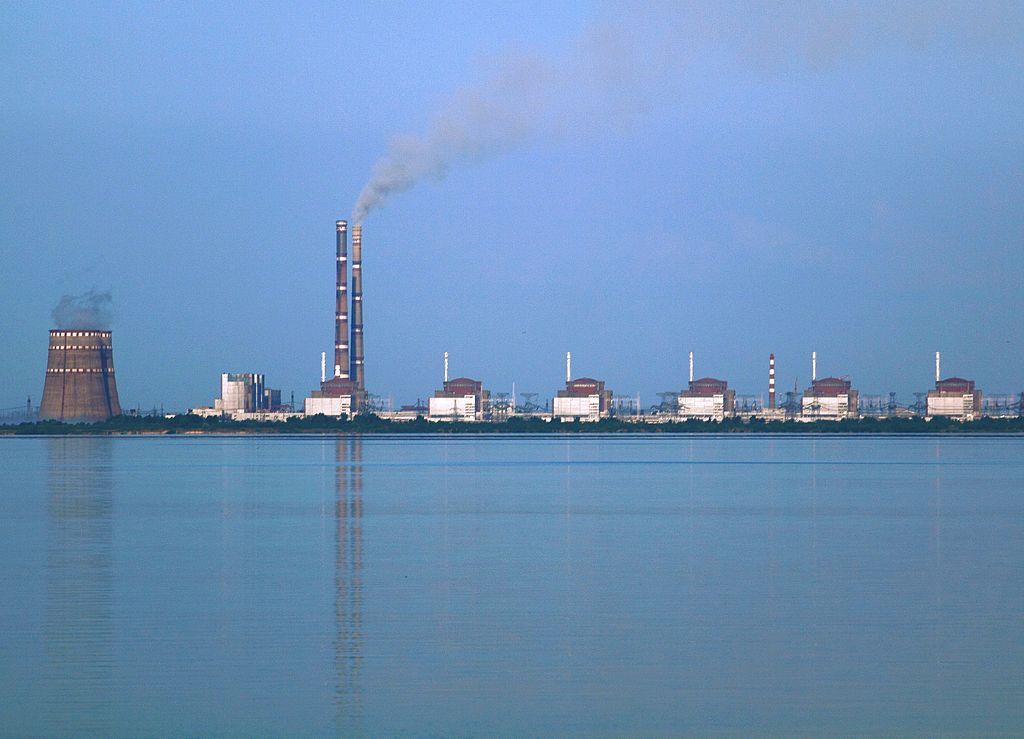A Ukrainian climate expert on the Zaporizhzhia situation and the winter energy outlook
By Jessica McKenzie | August 19, 2022
 Zaporizhzhia nuclear power plant in southern Ukraine. The two tall smokestacks are at a coal-fired generating station about 3km beyond the nuclear plant. Photo credit: Ralf1969 via Wikimedia Commons.
Zaporizhzhia nuclear power plant in southern Ukraine. The two tall smokestacks are at a coal-fired generating station about 3km beyond the nuclear plant. Photo credit: Ralf1969 via Wikimedia Commons.
Fear over a possible nuclear disaster at the Zaporizhzhia nuclear power plant in Ukraine rose this week, as both Russia and Ukraine warned that the other side could be planning a “false-flag” attack. Russian forces—currently in control of the plant—have ordered many of the Ukrainian workers who continue to run and operate the plant to stay home from work; only those workers who work on the power units themselves have been allowed on the premises, according to Ukraine’s state-run energy firm, Energoatom.
Earlier this month, the European Union and the United States called for Zaporizhzhia and the surrounding area to be demilitarized, but Russia has rejected the suggestion, saying it would make the plant “even more vulnerable.”
Oleh Savitskyi, a board member of the non-governmental organization Ecoaction and a climate and energy policy expert with the Ukrainian Climate Network who worked in the ministry of energy and environment protection of Ukraine until June, has been following the situation closely. The Bulletin reached Savitskyi by phone in Kyiv earlier this week to discuss the escalating situation at Zaporizhzhia, what happens if the plant goes offline, and the outlook for Ukraine’s energy supply in the coming months and years.
This interview has been condensed and edited for brevity and clarity.
Bulletin of the Atomic Scientists: What is going on at Zaporizhzhia right now?
Oleh Savitskyi: We have a pretty tense situation there. Russians have damaged several facilities at the site, they disabled one of the power lines by shelling. There are five major power lines which connect the Zaporizhzhia nuclear power plant to the Ukrainian grid, four 750 kV lines and one 330 kV line. And Russians have reportedly damaged two of those lines. And because of that, one of the units of the nuclear power plant had to be switched off because of the line outage.
If a nuclear power plant loses grid connection entirely, it becomes an emergency situation, because to cool off the reactors, the power plant still needs energy. And when it’s disconnected from the grid, all its own generation is zero, all the reactors are stopped in emergency mode. And to power the cooling pumps that provide cooling for the reactors, the plant will need to rely on backup diesel generators.
Bulletin: And how long will those last?
Savitskyi: In the best case scenario, a week if there are sufficient reserves of fuel. Usually there is a week-long reserve of fuel for each diesel generator, but since Russians are using Zaporizhzhia nuclear power plant as their military base, they could have been stealing that diesel fuel or using it for their vehicles. Nobody knows how much fuel is available. That is also assuming the diesel generators are well functioning and they are fully repaired in due time, and they are not faulty themselves.
Bulletin: I saw speculation that Russia wants to send the power from Zaporizhzhia to Crimea.
Savitskyi: There were allegations or statements that they want to connect it to Crimea. But it’s technically quite a challenge because that would mean splitting Ukraine’s grid and disconnecting the southern Ukraine from the rest of Ukraine.
In theory, it’s possible but considering that it can have countermeasures from Ukrainian side it’s very improbable. Already one of the substations in Crimea which is critical for getting the power from Zaporizhzhia to Crimea was damaged by an explosion.
Bulletin: I understand you know someone in the town near Zaporizhzhia?
Savitskyi: Yes, in Enerhodar the situation is terrible. Russians are kidnapping people. They have kidnapped hundreds of people and probably many of those people died. They were kidnapping all those who were expressing dissent, or opposing Russians. They also were just kidnapping people to blackmail their relatives, families and wanting ransom.
Bulletin: I understand that the number of staff members at Zaporizhzhia is—
Savitskyi: Dramatically declining? Yeah, it’s true.
Bulletin: So, what does that mean?
Savitskyi: That means that at some point, the operation of the nuclear power plant will not be possible. Because you need to have shifts. At a nuclear power plant there should always be several people for every task so you have some redundancy. You cannot have just one person responsible for some critical monitoring of reactor operation and safety systems. So it’s clearly a condition that the plants should be stopped before personnel become unable to deliver the minimal required level of oversight and their duties.
The reactors should be put into cold shutdown, because there is not enough staff to really maintain the normal operation of the power plant. And—
Bulletin: What would that mean for Ukraine?
Savitskyi: Zaporizhzhia was producing a significant share of Ukraine’s electricity. But it’s not indispensable, especially now. Since big industrial enterprises were destroyed in Mariupol, in other parts of Ukraine, the demand for electricity has dropped significantly. But in the winter, for sure, we would need Zaporizhzhia to go through the winter without having severe deficits of electricity. We will not have blackouts without Zaporizhzhia. But it would be challenging in terms of meeting the power demand in the winter.
By winter, the power plant should be under control of the United Nations, and it should operate normally safely and with the protection of the international community.
If Zaporizhzhia shuts down and remains down for a prolonged period of time, we would probably have to rely more on coal. And that would be a problem. Because we don’t have too much coal supplies, or domestic mines. Most of the mines were destroyed by Russians in eastern Ukraine. Since 2014, the eastern part Donestk region has turned into an environmental nightmare, it’s just—it’s apocalyptic. There is no drinking water. Most of the mines are abandoned and flooded and have become a source of toxic pollution because the mine water is heavily contaminated. And it’s gotten into the surface waters and aquifers. There’s practically no drinking water anymore.
Bulletin: Are there similar environmental risks at Zaporizhzhia?
Savitskyi: The radiation hazard is the main problem and not from the reactors themselves. The highest risk I see in this military situation is the spent nuclear fuel. There is a huge storage of spent nuclear fuel which is just in big concrete containers standing in the open. If there is an attack, accidental or intended, on those containers with spent nuclear fuel, it can be an extremely big emission of radioactive material.
Bulletin: What are you currently working on?
Savitskyi: Since March, we’ve advocated from every possible angle to cut off Russian income and cut off Russian influence and leverages in other countries and in the nuclear industry. Rosatom is one of the most powerful leverages Russia has and uses in many countries: in Egypt, in Turkey, in Asia. And Russia is using not only gas and oil supplies, but also its nuclear technology as a geopolitical weapon and the way to get a foot in the door in many countries, where they establish this link with authoritarian regimes, and also, like they did in Belarus, for example, they build a nuclear power plant, provide export credit for it, and then the state becomes an economic hostage to Russia.
Bulletin: My understanding is that your background is in climate and environmental issues. Were you working on nuclear issues before the war?
Savitskyi: As an environmentalist, my colleagues and I have been watching nuclear issues for decades. We were advocating for real energy security policy, for Ukraine to start strategically developing renewables and to diversify energy sources and to clean up Ukraine’s energy system. But there were major corruption issues, which blocked the development of renewables and alternative pathways. Energoatom was always mired in corruption.
Bulletin: What does that mean for Ukraine going forward?
Savitskyi: What is very much missing from the public sphere is that Ukraine doesn’t really have a credible plan for energy system development after the war, or even a plan to make it more resilient in the coming months. The ministry has failed to make sufficient preparations for winter resilience, and we might face a very hard winter this year. There could be a real deficit of energy supply in the winter and Ukraine will be much more vulnerable to Russian attacks on energy infrastructure.
Together, we make the world safer.
The Bulletin elevates expert voices above the noise. But as an independent nonprofit organization, our operations depend on the support of readers like you. Help us continue to deliver quality journalism that holds leaders accountable. Your support of our work at any level is important. In return, we promise our coverage will be understandable, influential, vigilant, solution-oriented, and fair-minded. Together we can make a difference.
Keywords: Russia, Ukraine, Zaporizhzhia, Zaporizhzhia nuclear power plant, nuclear energy, nuclear risk, renewable energy
Topics: Climate Change, Nuclear Energy















It’s plain that Putin wants to escalate. Give him a strong dose of his own medicine and take out some of his transmission lines connecting Moscow.
Dear Bulletinistas, So, yesterday I stopped myself from hitting the UNSUBSCRIBE button, due to my personal dissatisfaction with the modern editorial opinions and content expressed herein ….. but after almost fifty years of subscribing to the original Bulletin and this electronic version, I demurred. Today I see the headline that we’re gonna get a Ukranian update of Zaporizhzhia’s safety status…. So let me give you an example. “”There are five major power lines which connect the Zaporizhzhia nuclear power plant to the Ukrainian grid, four 750 kV lines and one 330 kV line. And Russians have reportedly damaged two of… Read more »